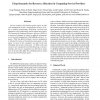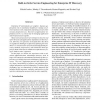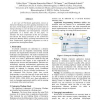IEEESCC
2008
IEEE
14 years 7 months ago
2008
IEEE
The semantic web services composition process arranges several web services into one composite to realize complex workflows. To do this, semantic metadata of web services’ desc...
IEEESCC
2008
IEEE
14 years 7 months ago
2008
IEEE
Service providers (SP) business goals require an efficient management of their computational resources in order to perform provisioning, deployment, execution and adaptation whic...
IEEESCC
2008
IEEE
14 years 7 months ago
2008
IEEE
IEEESCC
2008
IEEE
14 years 7 months ago
2008
IEEE
—This paper presents a novel approach to model a complex evolving system, a Digital Business Ecosystem (DBE) that takes the specific needs of Small and Medium-sized Enterprises ...
IEEESCC
2008
IEEE
14 years 7 months ago
2008
IEEE
Services can be characterized as activities in which providers and customers co-create value. The need for a tight collaboration between providers and customers is thus an importa...
IEEESCC
2008
IEEE
14 years 7 months ago
2008
IEEE
Interpreting legacy XML documents is a great challenge for realizing the vision of the Semantic Web (SW). This paper presents an algorithm to transform XML data into RDF- foundati...
IEEESCC
2008
IEEE
14 years 7 months ago
2008
IEEE
Enterprise IT environments are complex: business applications rely on distributed middleware running on diverse hardware with components depending on each other in many unexpected...
IEEESCC
2008
IEEE
14 years 7 months ago
2008
IEEE
A new type of Web-based applications, known as Enterprise Mashups, has been gaining momentum in the last years. Novel design principles are currently about to emerge allowing to c...
IEEESCC
2008
IEEE
14 years 7 months ago
2008
IEEE
In this paper, we present a model-driven, domaincentric tool allowing the specification of service-oriented ions through abstract services composition. Executable applications, ma...
IEEESCC
2008
IEEE
14 years 7 months ago
2008
IEEE
Service Oriented Architectures (SOAs) have emerged as a preferred solution to tackle the complexity of large-scale, complex, distributed, and heterogeneous systems. Key to success...







